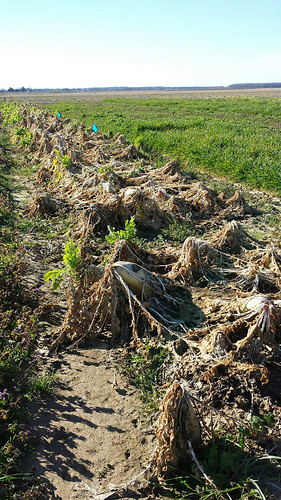Tillage radishes defeated by dense soil, but hold promise as winter nutrient lay-away
Fast Facts:
- Research tillage radishes defeated by heavy soil, but show other promise
- Roberts: Tillage radishes may be nutrient reservoirs
(365 words)
MONTICELLO, Ark. -- Research radishes at the Southeast Research and Extension Center
have found that the only way to grow is up.
Trent Roberts, soil scientist with the University of Arkansas System's Division of
Agriculture, said that the root vegetables' usual downward growth habit lends to their
promotion as a tool to reduce soil compaction and cut the need for deep tillage in
crop land.
"Unfortunately for these tillage radish, our soils -- heavy textured and poorly draining
-- did not allow them to root down or drill through the plow pan or restrictive layers
like they do in the upper Midwest," he said. "A lot of producers who have attempted
to use tillage radish have only seen the deep rooting on very sandy soils, where compaction
is not always a major concern."
At SEREC, the soil was so dense, even the largest 6- to 8- inch long and 3-inch wide
radishes surrendered, growing tubers above ground. While not so good for tillage,
Roberts said the vegetables still hold promise: "I think tillage radish have a place
in Arkansas as a winter cover crop, but I see them playing a completely different
role.”
Nutrient sponges
"Tillage radish are amazing at nutrient scavenging and nutrient retention," he said.
"The great thing about tillage radish is that their large tubers soak up nutrients
like a sponge and hold on to them during our winter months that are often very wet
and would result in a high level of leaching and ultimately nutrient loss."
Those absorbed nutrients that are released very quickly and are readily available
for whatever crop is being planted in the spring.
"I think we could get some huge benefits from the radishes from a nutrient retention
standpoint rather than compaction alleviation," Roberts said.
The tillage radishes are part of a larger winter cover crop study funded by the Arkansas Soybean Promotion Board. Roberts said the study is looking at the influence of planting date and nitrogen fertilizer rates on radish establishment and what effect that might have on soybean growth the following season. In addition to SEREC, the cover crop trials are being conducted at Division of Agriculture’s Pine Tree Research Station at Colt, the Rice Research and Extension Center in Stuttgart and the Vegetable Research Station at Kibler.
For more information about crop production, visit www.uaex.uada.edu or contact your
county extension office.
Pursuant to 7 CFR § 15.3, the University of Arkansas System Division of Agriculture
offers all its Extension and Research programs and services (including employment)
without regard to race, color, sex, national origin, religion, age, disability, marital
or veteran status, genetic information, sexual preference, pregnancy or any other
legally protected status, and is an equal opportunity institution.
# # #
By Mary Hightower
The Cooperative Extension Service
U of A System Division of Agriculture
Media Contact: Mary Hightower
Dir. of Communication Services
U of A Division of Agriculture
Cooperative Extension Service
(501) 671-2126
mhightower@uada.edu
Related Links

